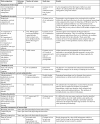Variations in policies for management of the third stage of labour and the immediate management of postpartum haemorrhage in Europe
- PMID: 17567419
- PMCID: PMC1974828
- DOI: 10.1111/j.1471-0528.2007.01377.x
Variations in policies for management of the third stage of labour and the immediate management of postpartum haemorrhage in Europe
Abstract
Background: The EUropean Project on obstetric Haemorrhage Reduction: Attitudes, Trial, and Early warning System (EUPHRATES) is a set of five linked projects, the first component of which was a survey of policies for management of the third stage of labour and immediate management of postpartum haemorrhage following vaginal birth in Europe.
Objectives: The objectives were to ascertain and compare policies for management of the third stage of labour and immediate management of postpartum haemorrhage in maternity units in Europe following vaginal birth.
Design: Survey of policies.
Setting: The project was a European collaboration, with participants in 14 European countries.
Sample: All maternity units in 12 countries and in selected regions of two countries in Europe.
Methods: A postal questionnaire was sent to all or a defined sample of maternity units in each participating country.
Main outcome measures: Stated policies for management of the third stage of labour and the immediate management of postpartum haemorrhage.
Results: Policies of using uterotonics for the management of the third stage were widespread, but policies about agents, timing, clamping and cutting the umbilical cord and the use of controlled cord traction differed widely. For immediate management of postpartum haemorrhage, policies of massaging the uterus were widespread. Policies of catheterising the bladder, bimanual compression and in the choice of drugs administered were much more variable.
Conclusions: Considerable variations were observed between and within countries in policies for management of the third stage of labour. Variations were observed, but to a lesser extent, in policies for the immediate management of postpartum haemorrhage after vaginal birth. In both cases, policies about the pharmacological agents to be used varied widely.
Figures
References
-
- Zhang W-H, Alexander S, Bouvier-Colle M-H, Macfarlane A. the MOMS-B Group. Incidence of severe pre-eclampsia, postpartum haemorrhage as a surrogate marker for severe maternal morbidity in a European population-based study: the MOMS-B survey. BJOG. 2005;102:89–96. - PubMed
-
- Brace V, Penney G, Hall M. Quantifying severe maternal morbidity: a Scottish population study. BJOG. 2004;111:481–4. - PubMed
-
- Bouvier-Colle MH, Ould EJ, Varnoux N, Goffinet F, Alexander S, Bayoumeu F, et al. Evaluation of the quality of care for severe obstetrical haemorrhage in three French regions. BJOG. 2001;108:898–903. - PubMed
-
- The EUPHRATES* Group. European Consensus on Prevention and Management of Post Partum Haemorrhage, 2005. [2007-March-25]. www.euphrates.inserm.fr/inserm/euphrates.nsf/AllDocumentsByUNID/95A14F46....
Publication types
MeSH terms
Substances
LinkOut - more resources
Full Text Sources
Medical


